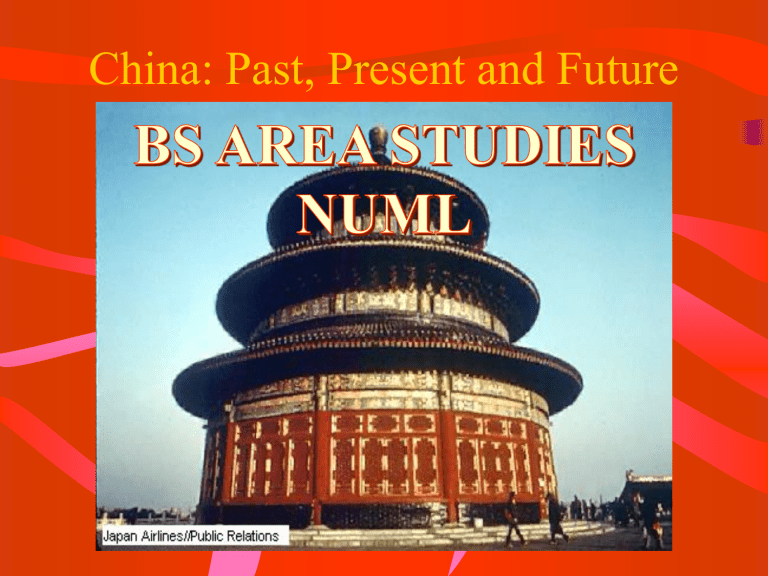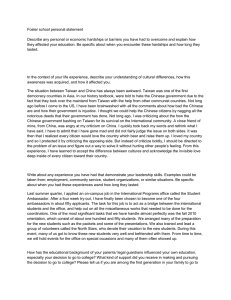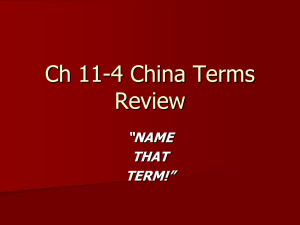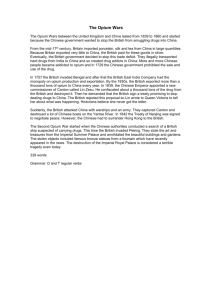
China: Past, Present and Future Historical Roulette • 3000 BC, Kingdom of Egypt • 2500 BC, The Greek Civilization • 2000 BC, Shang Dynasty in China • 500 BC, The Roman Empire • Middle Ages: China, Aztec in Mexico and the Incas of Peru • 1500 AD, Spanish Adventurers • 1700-1900 AD, British Empire • 1900 AD - ?, The United States of America Bronze Vessel, Shang Dynasty, China Metallurgy technology increased rapidly during the Shang Dynasty (1766?1027? BC) to meet increased demand for bronze ritual vessels. The World in 1820 • China was No. 1. in economic production and population. • China imposed its wishes in Asia and the emperor was the son of Heaven. • Chinese middle class enjoyed nice life. • But the world was changing. A lifestyle of luxury and pleasure The World in 2003 • China has fallen way behind in the economic race and is a poor country with a large population. • US is the only superpower and China does not seem to matter. • Huge social-economic problems. • How come? Falling Behind Per Capita Income (US$000) 25.0 22.3 19.5 20.0 16.3 15.0 1820 1992 10.0 5.0 3.1 1.7 1.3 0.7 0.5 0.0 China Japan UK US The Depressing Performance of Xerox Stocks (Billion) 1974 DELL CISCO Xerox MS $ 1989 1994 $ 0.13 $ 1.43 $ 7.16 5.13 $ 5.97 $ 11.27 $ 3.73 $ 32.32 1999 $ 106.70 $ 222.90 $ 27.81 $ 462.22 Xerox PARC invented PC, Mouse, icon, network, email, and operating system. Turning Point I: Opium War • • • • • Closed Door Policy Huge trade surplus with British, Gold inflow The extremely profitable opium business Opium Ban and confiscation in 1839 Opium War: China lost and gave Hong Kong island to British. • Humiliation from loss of Opium War II (18561860, burning down of the Summer Palace) • Loss to Japan and legitimacy. British Sales of Opium to China (Thousand Chests) Source: Mark Borthwick, Pacific Century, Westview Press, 1992 25 20 15 10 5 0 1729 1790 1819 1823 1832 Turning Point II: Treaty of Versailles • • • • • • • Over threw the emperor but little democracy. China was on the good side of WW I. Western powers sacrificed Chinese interests. Wilson disappointed the Chinese! Chinese intellectuals move to the left. Communist Party was established. Break up of China and chaos (warlords). Turning Point III:Japanese Invasion • • • • • • The rising sun Lack of resources Sino-Japanese War Lost Taiwan Invasion of Manchuria The Japan saved the Communists. The Unfortunate Generalissimo • Educated in Japan • Married US educated wife • On the cover of “Time” • Lost Civil War • Martial Law in Taiwan • Economic Takeoff • Foundation for Democracy A Controversial Tyrant • Born in a Middle Class Peasant Family • Never received western education • Never brushes his teeth • Had three marriages, the last one with a second rate actress, and numerous mistresses • A brilliant historian and ruler Civil War:Why Chiang Lost? • • • • • • Less ruthless. Bad marketing strategy (peasants). Bad macro-economic policy. Too much opposition within KMT. Historical tides. From Authoritarian regime to democracy. Turning Point IV: PRC Established • Nationalized Private Companies • Abolished foot bounding • Offered women working and education rights. • Pushed for industrialization • Totalitarian Regime • Prolonged political turmoil • Draconian Population policy Turning Point V: Cultural Revolution • Power Struggle at the top and at every level of government. • University closed. • Factory closed. • Stated Objective: Get rid of capitalists and establish socialist paradise- a fantasy • The nightmare ended in 1976. Nixon’s 1972 Historical Visit To China US: Vietnam Election Balance Russia China: Balance Russia Prestige New Direction The Legacy of “Great” Chairman Mao •Winning Civil War •The Anti-rightist Movement •Great Leap Forward (Irrational Exuberance?) •One Billion People •Break up with USSR •Cultural Revolution •Sino-US Relationship The Remarkable Deng •French visiting student •Veteran of Long March •“Capitalist-Running Dog” •Return to power •Second fall •Paramount leader •Economic reform •Tienanman Tragedy Turning Point VI: Deng’s Reform • To Get Rich is Glorious! • Over the last 20 years, China has experienced an economic growth unprecedented in human history. China’s overall economy is expected to catch up with the U.S. in 30 years, but will still be much less affluent than the U.S. • Economic Reform has fundamentally changed the structure of China’s Economy. Annual Real GDP Growth1987-1996 12.0% 9.9% 10.0% 8.5% 7.7% 8.0% 6.0% 5.1% 4.0% 3.1% 3.0% 2.3% 2.0% 0.0% China Tiger Cubs Four Tigers India Latin America Japan United States Effective Corporate Tax Rates Data Source: Goldman Sachs Japan US China Thailand Singapore Hong Kong 0% 10% 20% 30% 40% 50% 60% World Labor Costs in U.S. Dollars per Hour Manufacturing Sector Germany Japan France United States Italy Canada Britain Spain South Korea Singapore Taiwan Hong Kong Brazil Chile Poland Argentina Malaysia Mexico Czech Russia Thailand Indonesia China India 1995 Cost (US $) 1997 Cost (US$) 31.88 23.66 19.34 17.20 16.48 16.03 13.77 12.70 7.40 7.28 5.82 4.82 4.28 3.63 2.09 1.67 1.59 1.51 1.30 0.60 0.46 0.30 0.25 0.25 27.80 19.08 16.91 18.17 15.81 16.24 14.08 n/a 4.29 7.05 4.98 5.31 n/a n/a n/a n/a 1.81 n/a n/a n/a 0.39 0.22 0.33 0.26 Source: Morgan Stanley Research (End of Year Estimates) China’s Economic Relationship with the World Foreign Investment is pouring into China. China has become largely a trading nation. U.S. is running a huge trade deficit with China. • But China has used a large chunk of that trade surplus to buy U.S. Debt. Figure 1-8: Foreign Direct Investment (FDI, US$ Billion) $42.3 $45.0 $37.8 $40.0 $33.8 $35.0 $27.5 $30.0 $25.0 $20.0 $15.0 $11.2 $10.0 $5.0 $4.4 $3.4 $3.5 $3.1 $1.9 $2.3 $0 1986 1988 1990 1992 1994 1996 Figure 1-7: Industrial Growth Comparison among Different Sectors (1995) 60% 51% 50% 37% 40% 30% 20% 20% 15% 8% 10% 0% Total State Collective Individual J. V. Average Living Space Per Person for City Residents (square meters per person) 9 8.1 7.8 8 7.5 7 6 6.1 86 87 6.6 6.7 89 90 6.9 7.1 6.3 6 5.2 5 4 85 88 91 92 93 94 95 China Has Changed in Many Other ways China is run by technocrats instead of revolutionaries. The collapse of the Soviet Union gave the leadership a strong shock. Organized political dissent still not tolerated, but the system is much more open than before. People’s values are changing. 1976 Where leaders' children were educated University of Moscow (Chairman Mao's son) 2003 Drexel University (Jiang Zemin's son) Political indoctrination Several times a week Almost none, people are too busy making money Private ownership Encouraged Not allowed Popular clothing Blue or green Mao jacket Polo shirts, Levi Strauss jeans Cosmetics How dare you wear them! Avon, Revlon, Lancôme Paris Power lunch Chow Mein Big Mac Blockbuster movie Shining Red Star The Lord of Rings, Harry Potter Favorite music The East is Red Rock 'n roll, heavy metal Status drink Mao Tai Cognac XO Which Country is Socialist? • • • • • • • Minimum wage Lifetime employment Unemployment coverage Social security Health care Government influence in business Government bailout of weak companies The Third Generation College Education Speak English US-educated sons Outstanding performance in 1989 Tough problems to solve What Jiang Has Achieved and Left Over • A good economy • Market reform made significant progress • Kept promises in HK&Macao • Increase prestige in the world • First orderly transition of power, so far •State enterprises still lose tons of money •Farmers are not benefiting as much •Corruption wide-spread •Shaky financial institutions •Little progress in political reform The Fourth Generation •Tsinghua University Graduates •Has a son currently pursuing EMBA degree •A person with nice low-key personality •Pursued a conciliatory policy when visiting US •Cares about the disadvantaged •Will he lead? China’s Stated Socio-economic Objective for the 21st Century To continue its fast economic growth To maintain political stability To recover Taiwan • To become a modern country .China’s Main Conflict with the U.S. Trade surpluses International arms sales Taiwan • Human rights & Religious Freedom The Future Stability of China Rapidly rising population and pressing demand for jobs The growing economic disparity between Chinese farmers and city dwellers and the possibility for peasant unrest; Corruption that may cause widespread resentment among those who are left behind in the economic race; Weak Financial Sector China is too big for the world to have Chaos. The Growing Chinese Urban Population (million) 370 351 343 340 333 323 310 301 305 295 286 276 280 263 250 1986 1987 1988 1989 1990 1991 1992 1993 1994 1995 Turning Point VII: WTO Play by the rules Attract more foreign capital and technology Avoid annual congressional debate on MFN (NTN) Have access to world markets Develop legal Infrastructure for sustainable development China’s Future • Prosperity leads to Democracy • US & European educated officials are taking over • Elections at township level • Media activism • Dramatic changes get out of control • International pressure become counterproductive • A war with Taiwan • Economic and Political Disintegration




